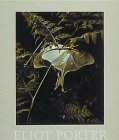
See larger photo
| The Color of Wildness: A Retrospective, 1936-1985
     
[Click on the appropriate flag to buy the book] | Product Details
Hardcover
176 pages
Aperture
Published 2001
Review
"[Porter's images] are a refreshment to the eye, a tonic to the spirit and an affirmation of beauty. [They] are secure in the history of themedium and contribute to the highest standards and achievements of the art.
-- Ansel Adams
About the Author
Eliot Porter, born in Illinois in 1901, began to photograph birds and landscapes as a boy. He was the recipient of numerous awards, including a Guggenheim Fellowship. He died in 1990.
Book Description
Eliot Porter's photographs present an eloquent call to respect and value nature, while taking careful note of humanity's varied relationship with it. Eliot Porter: The Color of Wildness, the first in-depth retrospective of Porter's work, reflects his intimate encounters with diverse ecosystems the world over. His photographs invite the viewer to observe more closely at the natural world and appreciate the breathtaking variety, complexity, delicacy, and beauty found there. Through such appreciation, Porter suggests, we can lead fuller, more balanced lives.
Over the course of his long career, Porter pursued a wide range of subjects. From personal landscapes, like the coast of Maine where he spent childhood summers, he constantly expanded his vision to encompass such remote and unfamiliar terrain as the Galapagos Islands and Antarctica. With the immense success in 1962 of his Sierra Club publication "In Wildness Is the Preservation of the World," Selections & Photographs by Eliot Porter, Porter became a sort of ambassador for environmental causes. An early and learned advocate of environmental conservation, his photographs continue to inspire contemplative and protective feelings toward nature.
The Color of Wildness also reveals how Porter's ecological interests led to his deepening fascination with humanity's cultural roots. Central to this expanded vision were his evocative portraits of Greek and Egyptian ruins and his extensive portrait of China, all work made late in his career.
This volume also investigates the artistic, scientific, and humanistic foundations of Porter's photography. The central essay by curator John B. Rohrbach addresses Porter's journey from medical student to world-renowned master of color nature photography. Detailing for the first time the artist's radical break with the classical black-and-white techniques of the master modernists Paul Strand and Ansel Adams, the essay reveals Porter's persistent commitment to his art and clarity of vision. An essay by Porter's son Jonathan, who often accompanied his father on photographic expeditions, discusses Porter's lifelong love of the natural world, his working methods, and his interests outside of photography. Writer Rebecca Solnit contributes an essay that positions Porter's work within the fledgling environmental movement and shifting political climate of the 1960s.
The Color of Wildness has been produced in the same Exhibit Format as Porter's landmark 1962 publication "In Wildness Is the Preservation of the World." In conjunction with the release of this book, the Amon Carter Museum, Fort Worth, Texas, has mounted a traveling exhibition of Eliot Porter's work. |
|
The Place No One Knew: Glen Canyon on the Colorado
Eliot Porter; David Ross Brower; & Glen Canyon Institute |  |
|
|
The Tree Where Man Was Born, That African Experience
Eliot Porter; & Peter Matthiessen |  |
|
The Color of Wildness: A Retrospective, 1936-1985
Eliot Porter; & Jonathan Porter |  |
|
| |

